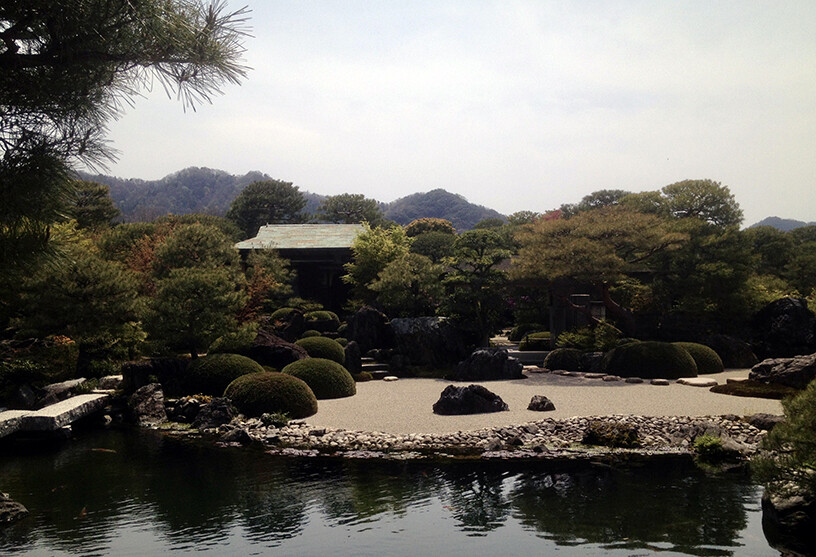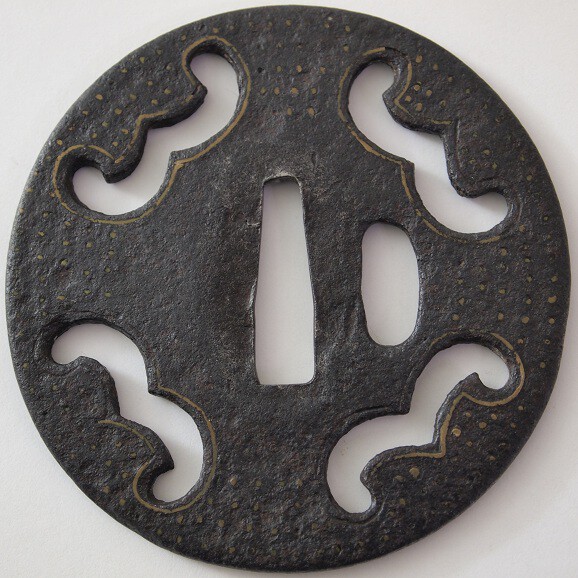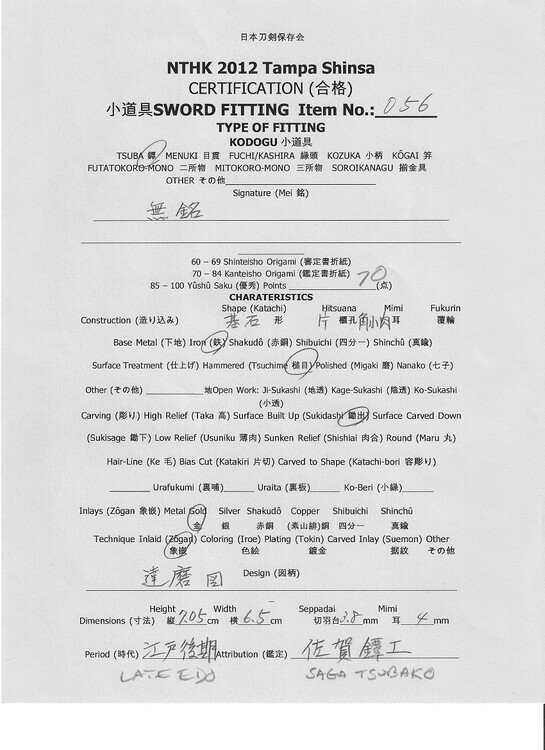-
Posts
2,886 -
Joined
-
Last visited
-
Days Won
3
Everything posted by Soshin
-
Hi Ford, Wonderful thoughtful reply to Charles question. I have learned something from just reading it. This little topic has been a great read. Thank you Ford, Charles, and Alan. Yours truly, David Stiles
-
Hi Ed, Thanks for taking the time to post photo of your Nihonto tsuba. With all do respect I can't see anything that makes me think Muromachi or Momoyama Periods for the age of the tsuba. In the photos you have provided of the tsuba. Often old blades will be remounted many times. They did do some lacquring of tsuba during the Edo Period but was more common before the Edo Period. Based upon the photos I would say late Edo to early Meiji Period for the age of the tsuba. I have been wrong many times and sometimes it is hard to judge from a few low resolution photos. Yours truly, David Stiles
-
Hi Christian, No I don't have a copy of that article. Post a copy or a link as I think other people might find it interesting. Thank you. Yours truly, David Stiles
-
Hi Everyone, John and Christian, I think you are right the ko-sukashi are stylized myoga (Japanese ginger). The whole design might be referred to as shiho (no) myoga (四万茗荷) in Japanese as the myoga are at the four directions. I have a NBTHK papered Owari tsuba with that type of four direction design on it. Here is some better photos of the tsuba both the omote and ura side. The brass sen-zogan is only around the four ko-sukashi which I like. The five rows of brass ten-zogan on the surface reminds me of this tsuba from the Yamabushi website: http://www.yamabushiantiques.com/BM%20Onin%20Tenzogan%20Tsuba.htm. It has a total of four rows of brass ten-zogan while mine has five rows. It like mine has sen-zogan around the ko-sukashi. Comparing my tsuba to the Yamabushi example the back lacquered iron is almost identical in color and texture. Yours truly, David Stiles
-
Hi Dirk, Can't clearly see the attribution on NBTHK shinsa origami. Can you post better photos? Overall a interesting piece and worth discussing. I didn't know they made kozuka out of ivory. Yours truly, David Stiles
-
Hi Everyone, Here is a really old tsuba I would like to post about new to my collection. :D It is a Onin tsuba with abstract ko-sukashi elements in four directions of the tsuba. About 2/3 of the brass ten-zogan is still present and almost all of the black lacquer. The measurements of the tsuba are 7.8 X 7.6 the thickness at the rim is 2.5 mm. The thin rim display nice linear tekkotsu. Based upon the color of the brass inlays, use of black lacquer, and abstract sukashi design I would date it's age from the middle to late Muromachi Period. Any suggestions about the ko-sukashi design would be helpful. Before coming to a US collection over 30 years ago it was mounted on a civilian Japanese sword during World War II and was located by the US collector in Malaysia during the 1970s. The Japanese sword was a complete loss but this tsuba remained likely due to the black lacquer was able to be restored. I have a new camera and will post better photos of it over the weekend. Comments, questions, and answers are welcome. Yours truly, David Stiles
-
Hi Mariusz K, This isn't my area of current study but I like the tsuba. The surface is nicely done. I hope more knowledgable people will reply. The black lacquer may indicate a early production. I have tsuba with this on it that likely dates to the middle to late Muromachi Period. Your truly, David Stiles
-
Hi Mark G., Thanks for liking my tsuba. I am not familiar with the Bungo group or school. Could you provide some additional information or where to find some additional information about this group or school? Thank you very much. Yours truly, David Stiles
-
Hi KM, The funny and ironic thing is these type of mistakes are the result of spelling autocorrect on my iPhone. I would go on to say don't over clean and leave the inside part of the sukashi alone. Only clean it if the rust is damaging the sukashi. Do not use any chemicals or oils to clean the rust. Yours truly, David Stiles
-
Dear John L., Generally the samething I said for Choshu can be applied to Aizu Shoami school. Thanks for your input. Yours truly, David Stiles
-
Hi Everyone, I am not taking anything personally and considering it a valuable learning experience. I do need to work on a article I am writing. Tom H., I think Choshu would be a good place to start my search. The school was very large and prolific. Their quality also has a board range from average to masterpieces. Yours truly, David Stiles
-
Hi Ford, Just to let you know that this tsuba is not the end all be all of my collection. :D I would rate it on the lower side of my collection among the few things that I like but would never bother submitting to Shinsa. I was thinking it was a unsigned school piece at best but it might just be a obscure unsigned country piece made during the later part of the Edo Period and not really fitting in anywhere. Outside of the NMB people are calling for me to write so I will take a break from message board and come back to it once I have completed the other hobby related projects in my free time between work hours. Thanks again for you insights and observations as a modern day tsubako on the subject. Yours truly, David Stiles
-
Hi Ford, I think the rough carving is intentional on the part of tsubako as well as a limitation of the medium. Sometimes tsubako would strive for simplicity, rusticity, and gauche in such a bold design. I was referring to the carving as katakiri-bori because the angle of the cuts by the chisel long the surface of the tsuba. I would agree in kinko tosogu the carving of katakiri-bori is often complex and looks like strokes of a painters brush. I think there are three factors effecting the cuts of the chisel in this context one is the softness of the medium in the case of kinko tosogu made of something like shakudo, shibuchi, or something hard like iron, the skill of the artisan, and intended effect of the design as controlled by tsubako. Hi Fred D., Thanks for the comment. I love how the rim and overall shape of the tsuba is included into the design on the tsuba. The brass dot inlays also do a good job contrasting with the darkness of the iron and highlighting the peddles of the Wisteria. Yours truly, David Stiles
-
Hi Ford, Thanks for the reply and the help. You are right to not put much emphasis of the inlays. Can't sleep so I was up looking at some of my many tosogu books. From looking at how the Wisteria design is rendered I think the technique is katakiribori (片切彫) which I don't see often in iron. This carving technique is more often seen in kinko tsuba and other tosogu. The carving looks to extend into the shape of the rim forming the individual petals of the Wisteria flower. The adjusting chisel marks (yose-tagane) around the nakago-ana as well as the shape of the kogai-hitsu ana reminds me of some of the Higo schools. I am not to knowledgeable when it comes to Higo schools in general and will need to do more research on that. :? Yours truly, David Stiles
-
Hi Everyone, I often don't list tsuba help topics on the NMB as I have became more experienced (10 years now) but this new tsuba of mine I don't have a clue in terms of the school. :? It has brass inlays that by virtue of their color indicates a early production period when brass was imported from China before the Edo Period. The style of inlay is different then what you see in Heianjo, Onin, or Kaga tsuba therefore the idea of Ko-Shoami comes to mind as they also often used brass inlays but in a different style. The measurements for the tsuba are as follows: 8.0 X 7.5 cm with a tickness of 4 mm at the mimi as well as the seppa-dai. Thank you for taking the time to read and reply to my post. The design in Japanese is Fuji meaning the Japanese Wisteria flower (Wisteria floribunda). The Wistera flower is often found in the kamon of samurai of the Kaga Province modern day Yamanashi Prefecture west of Tokyo near Mount Fuji. Yours truly, David Stiles
-
Hi Rob M., Could you please list the thickness of the tsuba at the rim also? Is the rim or center of the tsuba the thickest? Thank you. Yours truly, David Stiles
-
Hi, The first tsuba is a tempo tsuba and a nice one circa the late Edo Period. The main characterics are the large size, apparent hammer marks (tsuchimei-ji), and hot stamp designs. The second tsuba I am not sure about. Yours truly, David Stiles
-
Hi Rob M., I would try to remove some of the rust. Using bone or irony is fine. Please provide measurements and some shots of the rim. It will help ID the tsuba. Yours truly, David Stiles
-
Hi Everyone, Not sure about the first two but the third one is a Nara school tsuba like middle Edo Period. It is not Ko-Nara. Hope you find the information helpful. Yours truly, David Stiles
-
Hi Peter F., I was thinking Shoami circa middle Edo Period early 1700s. The iron is very similar to a one I have in my collection. I don't see any kebori on your tsuba like the one refernced. Kebori and very sharp ji-sukashi is often seen in Akasaka school work. Yours truly, David Stiles
-
Hi Fred D., I really like the Saotome tsuba. It is a really nice find at the show congratulations. I also purchased a early Saotome tsuba that I think is from the late Muromachi Period. I was thinking the design is a cross (mokko). It has both copper and shakudo sekigane. Here is a photograph of my Saotome tsuba. Enjoy. Curtis R., Sorry to hear about your car accident hopefully you will be able to make it to another show this year. Take care. Yours truly, David Stiles
-
You could be right it's hard to see if the rim is a fukurin or iron polished and turned up like my Daruma tsuba rim is. Pete's observation is a vaid one. Mid to late Edo period Shoami would make sense. With all the inserts being original to the tsuba. Nice tsuba I like it. Yours truly, David Stiles
-
Hi Alex, The rim is very similar to my tsuba it is a type of small turn back rim referred to as uchikaeshi-mimi (打返耳) in Japanese. The many ko-sukashi elements, that have been later filled with shakudo (赤銅), thickness of tsuba plate, and style rim reminds be of Edo Period Katchushi (甲冑師) (i.e. armor makers tsuba). Providing complete measurements including thickness would be helpful. Yours truly, David Stiles
-
Hi Henry, I would say that my tsuba Daruma image does look more like the woodblock print by Yoshitoshi circa 1887 freatured in the Wikipedia entry for Daruma. Especially when comparing them to the classic pieces made by Kaneie and Nobuie posted on this thread. Yours truly, David Stiles
-
Hi Henry Wilson, I would agree both the Nobuie and the Kaneie has some influence on the design of my tsuba even though the school was well known to copy Kaneie masterpieces. Does anyone know if the Nobuie tsuba with Daruma and Kanji was part of the orignal publication of the Nobuie tsuba Oshigata made by Nakamura circa 1850? If so then my tsuba was likely made around 1850. The Kanji in the air above Daruma head is likely a Zen Buddhist Koan (公案) as Daruma is a common subject of many Koan used as a Zen meditation aid. A really well know one featuring Daruma is as follows: Hi Eric, Here a black and white copy of the NTHK worksheet. Some of the information I have taken and included it in the write up. Thanks for the interest. Yours truly, David Stiles









